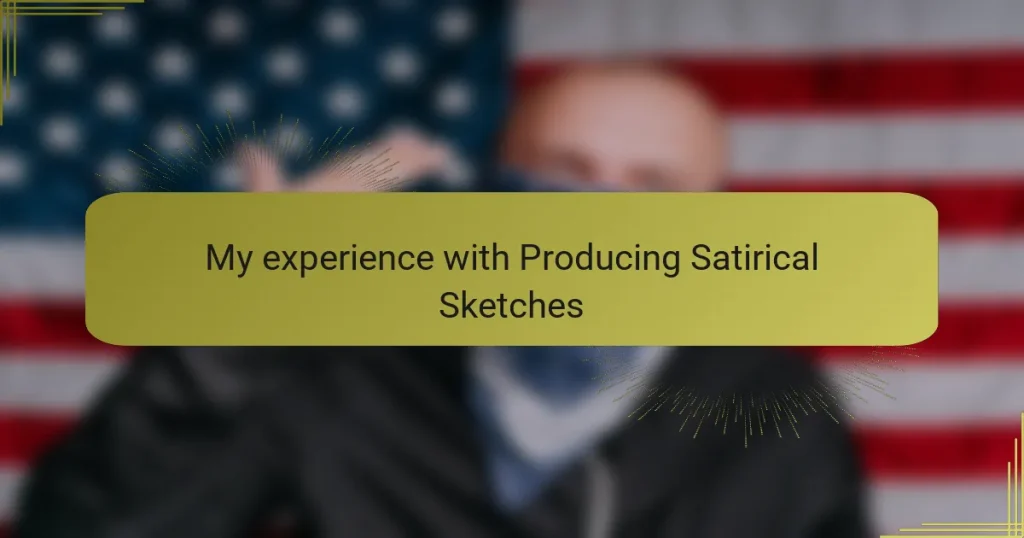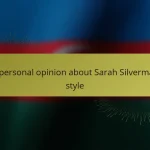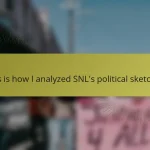Key takeaways
- Political satire combines humor and critique to provoke thought about societal issues and leaders.
- Effective satire requires careful timing, relatable content, and a balance between humor and sensitivity.
- Collaborative efforts enhance sketch production, leading to refined ideas and impactful performances.
- Key lessons from awards experiences include the importance of authenticity, timing, feedback, and audience connection.
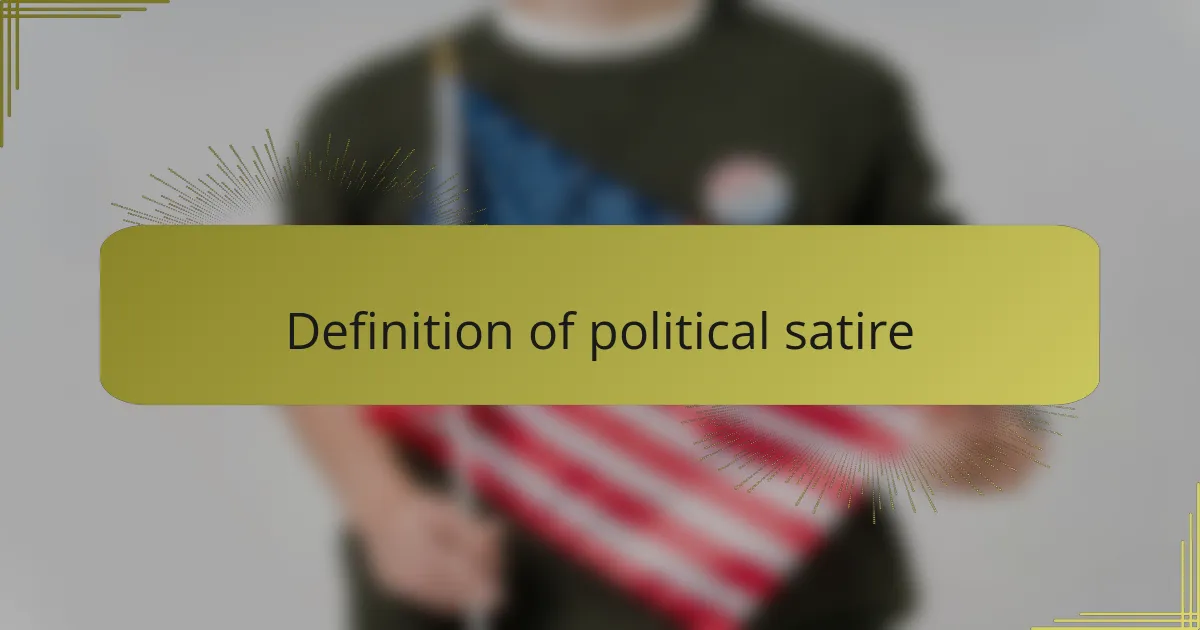
Definition of political satire
Political satire is an art form that uses humor, irony, and exaggeration to critique society and its leaders. It’s fascinating how a cleverly crafted joke can shine a light on serious issues, isn’t it? I remember watching a satirical sketch that made me laugh while simultaneously provoking deep thoughts about political decisions.
At its core, political satire often aims to expose the absurdities of public figures and their policies, leading us to question the status quo. I’ve found that when a comedian skewers a politician, it not only entertains but also encourages us to reflect on our own beliefs. Can humor really influence public opinion? My experience suggests it can, as laughter creates connections and opens discussions about vital topics.
Through clever storytelling and sharp wit, political satire serves as a mirror, reflecting the flaws in our governance while engaging audiences emotionally. It’s a powerful reminder that humor can spark change, pushing us to consider the implications of political actions and the need for accountability. Have you ever felt moved to act after a satirical piece? I certainly have; it’s a testament to the impact of satire in shaping our perspectives.
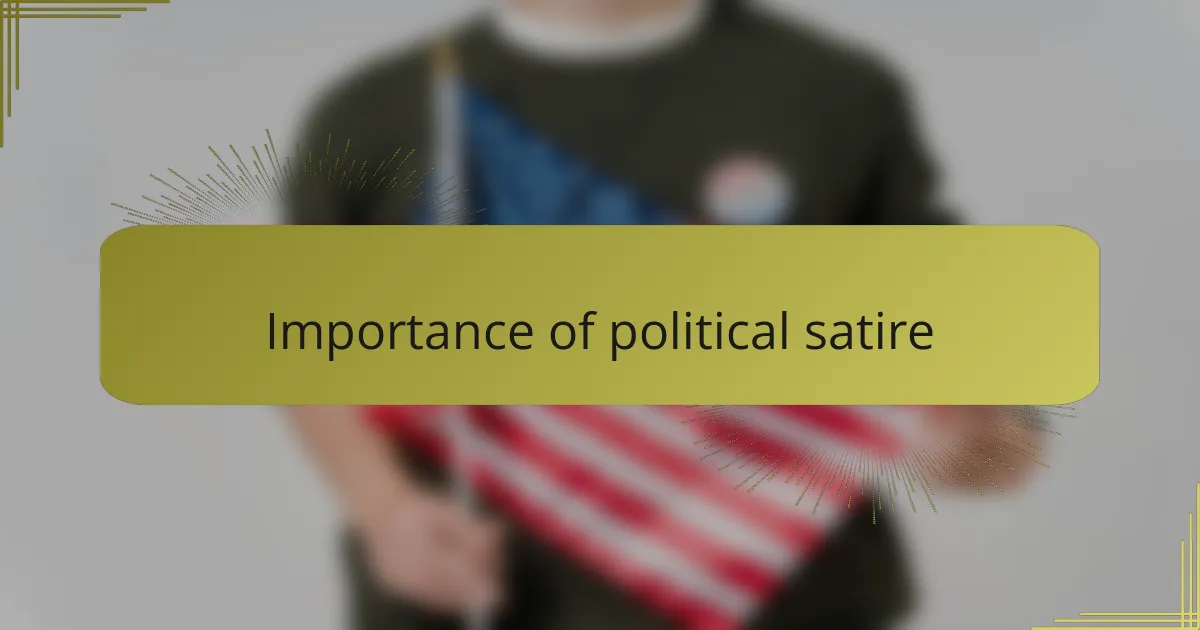
Importance of political satire
Political satire holds a mirror to society, reflecting the absurdities and failures of those in power. In my experience, it acts not only as a form of entertainment but also as a catalyst for critical thinking. When I watch or create a sketch, I feel the power of humor to open people’s minds and spark conversations about serious issues that often get overlooked.
The beauty of political satire lies in its ability to simplify complex topics. For instance, when I produced a sketch highlighting a political scandal, I noticed how laughter could transform skepticism into dialogue among viewers. It’s about taking heavy subjects and lightening them, making them accessible and engaging for everyone.
Here’s a brief comparison of the impact of political satire versus traditional news media:
| Political Satire | Traditional News |
|---|---|
| Engages through humor | Informs with facts |
| Encourages critical thinking | Provides straightforward reporting |
| Provokes emotional responses | Focuses on neutrality |
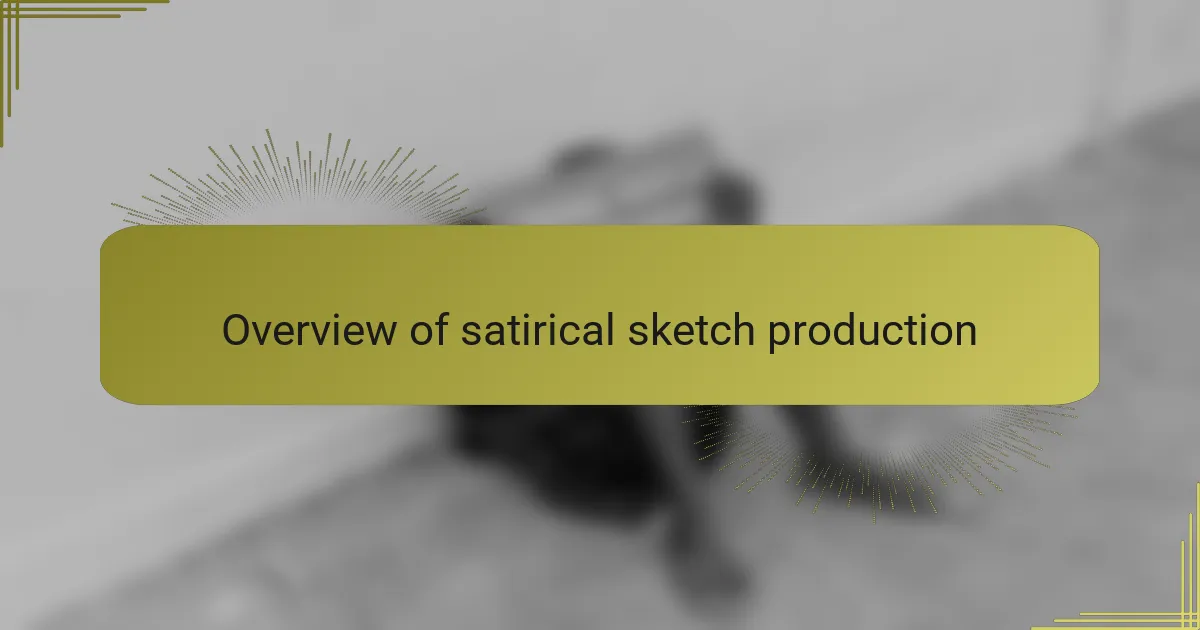
Overview of satirical sketch production
Producing satirical sketches requires a unique blend of creativity and critical insight. I remember my first attempt, where I felt both exhilarated and terrified. How do you balance humor while delivering a meaningful message? Through trial and error, I learned that the best sketches often stem from a personal connection to the topic at hand, allowing me to tap into genuine emotions and reactions.
The production process involves various stages, from brainstorming ideas to writing scripts and rehearsing. I’ve often found that collaboration is key; bouncing ideas off fellow creators can lead to unexpected gold. What’s fascinating is how a single phrase can evolve through discussion, refining the comedic punch while ensuring the message remains sharp. Each rehearsal reveals new angles, making each sketch a living, breathing entity before it even hits the stage.
Engaging the audience is the ultimate goal, and I’ve found that timing is everything in this respect. After performing a sketch, the response from the audience can be electrifying or a delicate silence—it’s a reminder of the fragile nature of humor. Have you ever delivered a joke that fell flat, only to realize later that perhaps the timing or context wasn’t right? I certainly have, and those moments have taught me the importance of pacing and understanding the audience’s mood when crafting satire.
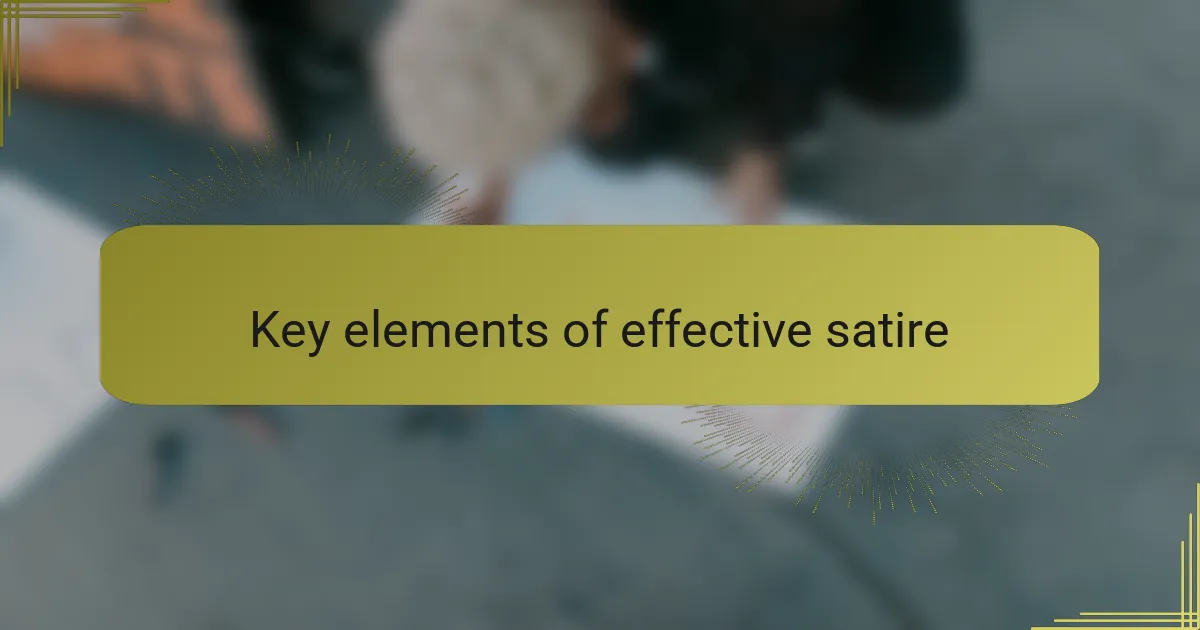
Key elements of effective satire
The essence of effective satire lies in its ability to blend humor with a pointed critique of society. I remember crafting a sketch that poked fun at a widely discussed political event. It wasn’t just about getting laughs; I wanted to make my audience think about the underlying message. It’s often said that the best humor is born from truth, and I wholeheartedly agree. When audiences can relate to the absurdities presented, the impact is amplified.
Another key element is timing. I’ve experienced the thrill of delivering a punchline that hits just right, and conversely, the cringe of a joke that falls flat. It’s fascinating how the right timing can elevate a simple idea into something profound and memorable. Have you ever found yourself laughing not just because something is funny, but because it resonates deeply? That’s the magic of satire—it combines wit with timing to create a moment that lingers in thought.
Moreover, exaggeration plays a crucial role in satire. It allows me to highlight the ridiculousness of certain situations, making the absurdities of political life even more pronounced. I recall a sketch where I exaggerated a politician’s traits to the point of caricature. While it was amusing, it also shed light on real issues that often go unnoticed. In my view, successful satire challenges us to confront our beliefs by illuminating what we may otherwise overlook. Isn’t it interesting how laughter can lead us to question the very fabric of our society?
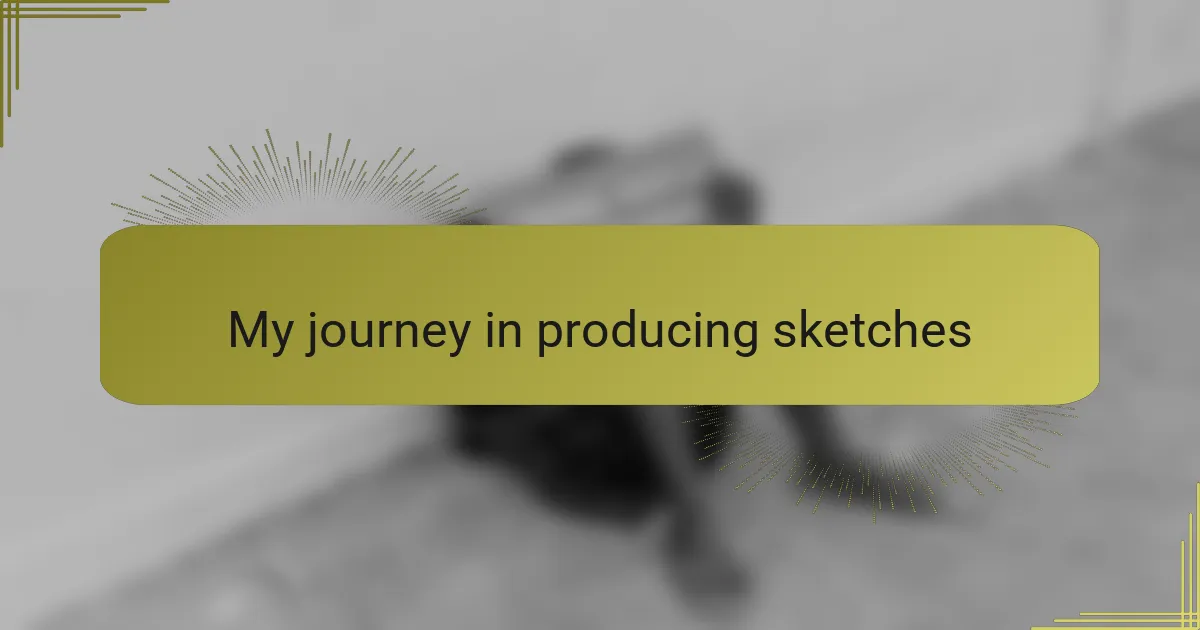
My journey in producing sketches
Producing sketches has been quite the adventure for me. Early on, I dived into writing with this mix of excitement and doubt. I vividly recall my first sketch, where I accidentally turned a simple line about a political figure into a full-on comedic rant after a friend encouraged me to exaggerate. It was in that moment I realized the power of humor to amplify truth. Have you ever had a creative epiphany that seemed to change everything? That was mine.
As I progressed, I began to appreciate the collaborative aspect of sketch production more deeply. Working with a talented group of writers and performers opened my eyes to new perspectives. One memorable night, we spent hours laughing over a script that flopped in our first table read, only to fine-tune it into something that resonated deeply with our audience days later. It’s striking how a collective effort can transform an initial idea into something vibrant and impactful. Wouldn’t you agree that the best ideas often come from lively discussions and shared inspiration?
Looking back, each sketch I produced taught me invaluable lessons about timing and audience engagement. There was this particular performance where I delivered what I thought was a stellar punchline, only to be met with an unsettling silence. I learned quickly that humor is as much about reading the room as it is about the script. How do you tap into your audience’s vibe? These experiences have shaped my approach, reminding me that every audience is unique and deserves a sketch that resonates with their shared experiences.
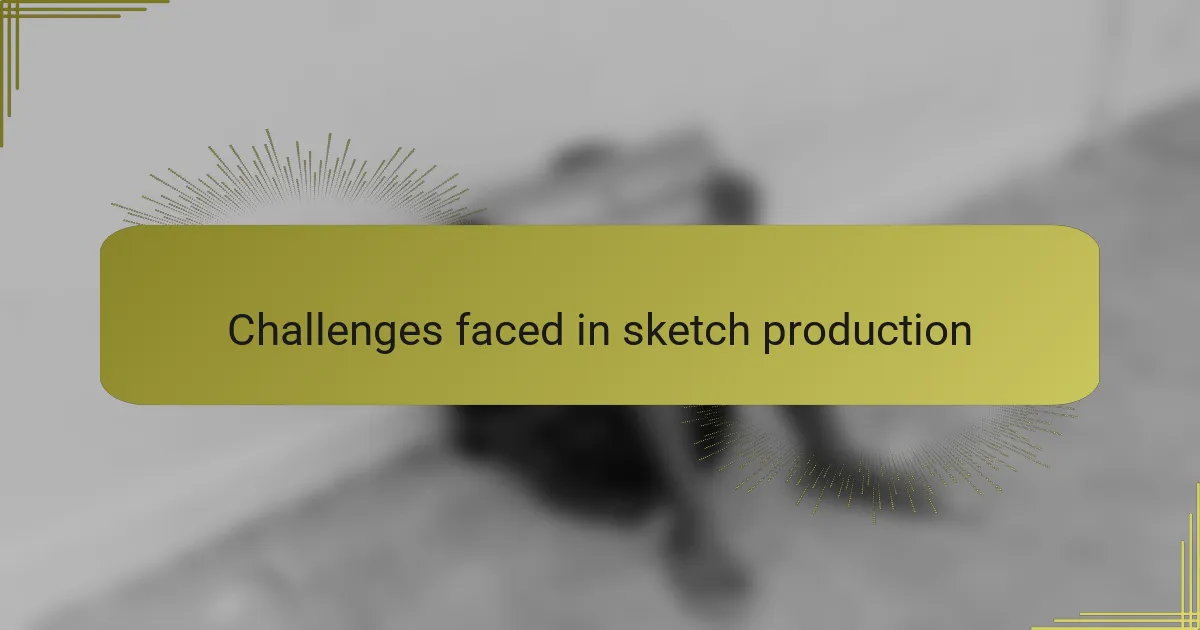
Challenges faced in sketch production
Producing satirical sketches comes with its fair share of challenges. One major hurdle I’ve encountered is balancing humor with sensitivity. It’s essential to be funny without crossing lines that might alienate potential audiences. For instance, I once crafted a sketch poking fun at a recent political scandal, but I had to rethink certain punchlines after realizing they could be hurtful to those directly affected.
Another significant challenge is time management. There are strict deadlines in production, and ensuring that each sketch is not only timely but also polished can be quite stressful. I vividly remember the rush I felt during the final days before an awards show. I learned that collaboration and open feedback from peers can alleviate some of that pressure while also enhancing the overall quality of the work.
Lastly, the risk of backlash is always present. When tackling controversial subjects, I’ve found it crucial to anticipate not just the laughs but also the potential criticisms. That balance is what often keeps me awake at night, pondering over every word and idea in my sketches.
| Challenge | Details |
|---|---|
| Balancing Humor | Ensuring jokes are funny without being offensive |
| Time Management | Deadlines create pressure to produce quality content |
| Risk of Backlash | Controversial topics may provoke criticism |
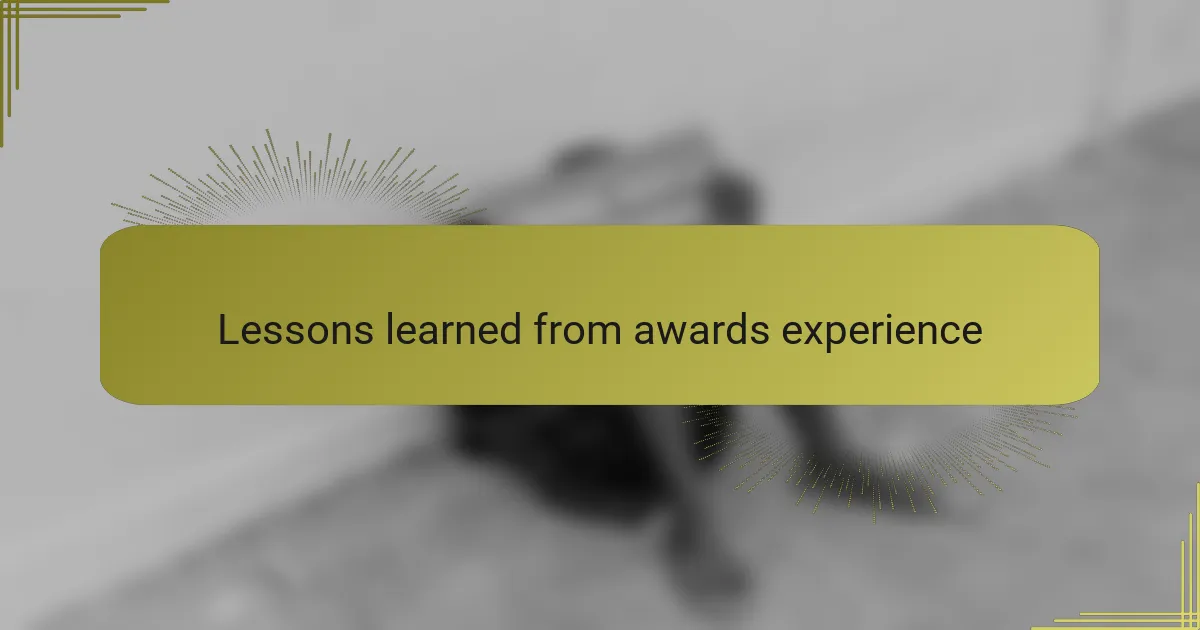
Lessons learned from awards experience
Experiencing the thrill of being recognized at a political satire award ceremony taught me invaluable lessons about the art of humor and the impact it can have. I remember the moment when my sketch was nominated; it felt surreal to see my work appreciated. I realized that satire isn’t just about making people laugh; it’s about provoking thought and stirring conversations around serious issues.
From this journey, I learned several key lessons:
- Authenticity matters: It’s essential to stay true to your voice and perspective.
- Timing is crucial: The right joke at the right moment can spark powerful conversations.
- Feedback is a gift: Constructive criticism helps refine your craft.
- Audience connection: Understanding the audience can make or break a sketch.
- Embrace vulnerability: Sharing personal stories can create deeper connections and relatability in your work.
